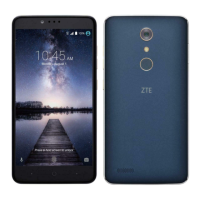116
FCC ID: SRQ-Z981.
For body worn operation, this device has been tested and meets the FCC RF exposure guidelines
for use with an accessory that contains no metal and the positions the handset a minimum of 1.0
cm from the body. Use of other enhancements may not ensure compliance with FCC RF exposure
guidelines.
If you do no t use a body-worn accessory and are not holding the device at the ear, position the
handset a minimum of 1.0 cm from your body when the device is switched on.
FCC Compliance
This device complies with part 15 of the FCC Rules. Operation is subject to the following two
conditions: (1) This device may not cause harmful interference, and (2) this device must accept
any interference received, including interference that may cause undesired operation. Caution:
Changes or modifications not expressly approved by the manufacturer could void the user‟s
authority to operate the equipment.
NOTE: This equipment has been tested and found to comply with the limits for a Class B digital
device, pursuant to part 15 of the FCC Rules. These limits are designed to provide reasonable
protection against harmful interference in a residential installation. This equipment generates,
uses and can radiate radio frequency energy and, if not installed and used in accordance with the
instructions, may cause harmful interference to radio communications. However, there is no
guarantee that interference will not occur in a particular installation. If this equipment does cause
harmful interference to radio or television reception, which can be determined by turning the
equipment off and on, the user is encouraged to try to correct the interference by one or more of
the following measures:— Reorient or relocate the receiving antenna.— Increase the separation
between the equipment and receiver.— Connect the equipment into an outlet on a circuit different
from that to which the receiver is connected.— Consult the dealer or an experienced radio/TV
technician for help.
Hearing Aid Compatibility (HAC) regulations for Mobile phones
In 2003, the FCC adopted rules to make digital wireless telephones compatible with hearing aids
and cochlear implants. Although analog wireless phones do not usually cause interference with
hearing aids or cochlear implants, digital wireless phones sometimes do because of
electromagnetic energy emitted by the phone's antenna, backlight, or other components.

